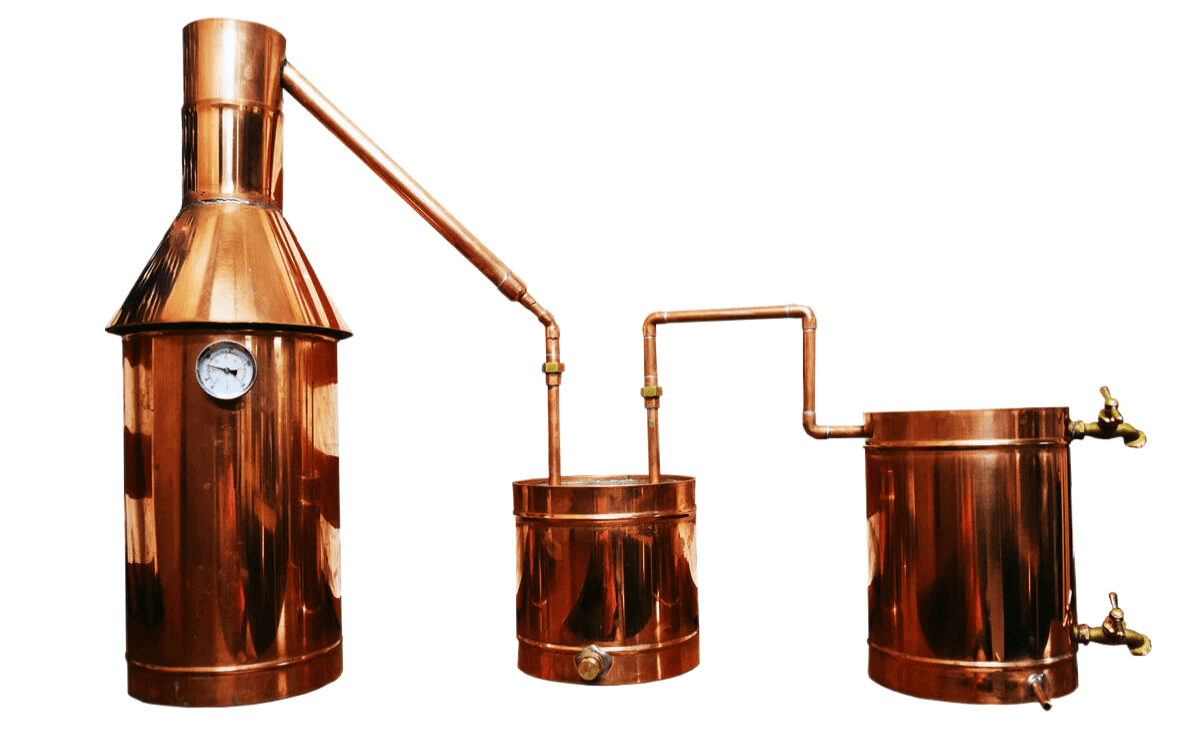Moonshine and Appalachian Copper Stills
Brewing using Appalachian copper stills is an essential element of our culinary tradition.
The region has produced some of the most well-known American beers and lagers, as well as a diverse selection of wines.
Nonetheless, despite its popularity, there remain unanswered issues concerning the technology.
We’ll look at the history of copper stills, the pros and cons of utilizing them, and how to use them to prepare traditional recipes.

Origins
Despite the fact that making whiskey is illegal in the United States, moonshine has long been a part of Appalachia’s heritage.
In the 1700s, some Scots and Irish immigrants arrived, bringing with them the habit of brewing a powerful drink.
This has traditionally been done with maize. This was a filling grain with a good shelf life. Farmers were eventually able to transport this grain more readily.
Strong drinks have been a popular way to unwind for ages. As a result, Appalachian towns were notorious for brawls and emotional instability. However, whiskey manufacturing contributed to the region’s social, economic, and political landscape.
The craft was nearly dead in the late twentieth century, but it has made a resurgence. Many moonshiners are rediscovering the skill of distillation. As a result, there is a greater need for stills and distillation equipment. In reality, Zane Bailey, a self-taught welder who grew up in the Greenville region, has been associated with his family’s business, Kayden, in Greenville.
He has also sold stills to consumers for $5,000 or more. Customers, he claims, buy them for ornamental purposes.
While the government did tax home distillers, the penalties were not nearly as severe as they are now.
The tariff was dependent on the still’s capacity. Because the administration had no idea who had withdrawn, it was simple to disregard them.
As a result, Appalachians began to profit from illegal whiskey production. In reality, their product was a widely used currency in the area.
They might seek assistance from their neighbors, and if their neighbors had a vendetta, they could convert it into cash.
Following the Civil War, a government tax was imposed on home distilleries.
It was also against the law to distill alcohol at home. As a result, several moonshiners devised methods to conceal their stills.
They constructed ruins beneath a tree or in an abandoned cave.
They would frequently add branches to the tree.
Law enforcement agents eventually destroyed these stills.
Moonshine production is still practiced in southern Appalachia today.
It has aided many farmers in the region in maintaining their financial stability.
However, many people continue to use alcohol in violation of the law.
Recipes from the past
A traditional copper still is ideal for a shotgun or a still and still.
Copper is a useful material that is well suited to the demands of distilling and maturing spirits.
Copper stills have long been the preferred method of producing bourbon, gin, and whiskey.
There are several kits available for the do-it-yourselfer.
The majority of them are armed with a bevy of clever tools and gimmicks.
In fact, some are so thoroughly thought out that you can produce your own rum.
Aside from the typical suspects, you might be surprised to find a number of customized firms, many of which specialize in manufacturing one-of-a-kind custom copper stills.
Whether you are a seasoned aficionado or a wannabe beginner distiller, the quality of their goods will leave you speechless.
Among their products are a number of specialty spirits, such as bourbon, gin, whiskey, and vodka, among others.
Unlike other distilleries, they are willing to let you choose your own price.
Furthermore, you may get a kit for a price close to that of a stylish custom-built one.
While you’re about it, you might as well get a nice bottle of whiskey for your visitors.
Copper still has disadvantages
It is not commonplace to use a copper still to make moonshine.
However, there are several disadvantages to this type of still.
You must ensure that you have enough space to operate it.
You should also make sure you have a decent heat source.
Before each run, you must clean the still. You should also make certain that the still is safe to use.
You should think about purchasing an easy-to-use moonshine still.
This increases the chance of successful outcomes.
It is also a good idea to consider getting a stainless steel moonshine still.
This type of still is less costly and easier to clean than copper stills.
It also does not leave any copper sulfate in the mash. This sulfate has the potential to alter the flavor of your moonshine.
Some individuals prefer to buy a still kit that serves as both a still and a fermentor.
This will help you save a lot of space. The spill kit also includes a big saucepan to cook your mash in.
You may also heat your mash using an induction burner.
The mash might be harsh on the copper.
After each run, you will also need to clean the still. This prevents the mash and other components from being soiled.
Another downside of utilizing copper is that it is still expensive to acquire.
This may deter new moonshiners. Stainless steel moonshine stills are significantly less expensive, and they do not require copper sulfate to be neutralized.
You must also ensure that you have enough space to keep your moonshine still.
This is critical if you intend to brew a large amount of moonshine.
If you want to create moonshine for human consumption, you must do so in a sterile atmosphere.
In addition, you’ll need a safe heat source to power the still.
This is especially essential if you intend to employ chemicals to get a characteristic burn.
